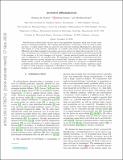Activated diffusiophoresis
Author(s)
Rohwer, Christian M; Kardar, Mehran; Krüger, Matthias
DownloadSubmitted version (2.262Mb)
Open Access Policy
Open Access Policy
Creative Commons Attribution-Noncommercial-Share Alike
Terms of use
Metadata
Show full item recordAbstract
Perturbations of fluid media can give rise to non-equilibrium dynamics, which may, in turn, cause motion of immersed inclusions or tracer particles. We consider perturbations ("activations") that are local in space and time, of a fluid density which is conserved, and study the resulting diffusiophoretic phenomena that emerge at a large distance. Specifically, we consider cases where the perturbations propagate diffusively, providing examples from passive and active matter for which this is expected to be the case. Activations can, for instance, be realized by sudden and local changes in interaction potentials of the medium or by local changes in its activity. Various analytical results are provided for the case of confinement by two parallel walls. We investigate the possibility of extracting work from inclusions, which are moving through the activated fluid. Furthermore, we show that a time-dependent density profile, created via suitable activation protocols, allows for the conveyance of inclusions along controlled and stable trajectories. In contrast, in states with a steady density, inclusions cannot be held at stable positions, reminiscent of Earnshaw's theorem of electrostatics. We expect these findings to be applicable in a range of experimental systems. The phenomena described here are argued to be distinct from other forms of phoresis such as thermophoresis.
Date issued
2020-02Department
Massachusetts Institute of Technology. Department of PhysicsJournal
Journal of Chemical Physics
Publisher
AIP Publishing
Citation
Rohwer, Christian M. et al., "Activated diffusiophoresis." Journal of Chemical Physics 152, 8 (February 2020): 084109
©2020 Authors
Version: Original manuscript
ISSN
1089-7690